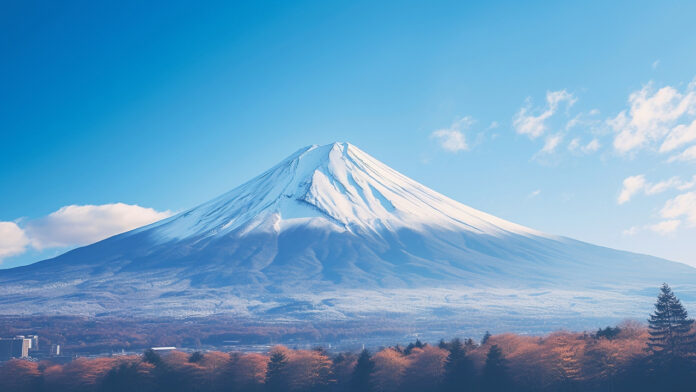Mount Fuji, Japan’s tallest and most iconic peak, captivates the imagination with its symmetrical cone, snow-capped summit, and timeless beauty. Revered as a symbol of Japan’s natural wonders and spiritual heritage, Mount Fuji has long inspired artists, poets, and adventurers alike. In this article, we embark on a journey through the fascinating world of Mount Fuji facts, exploring its rich history, geological wonders, cultural significance, and outdoor adventures that continue to draw visitors from around the globe.
Geological Marvel
Volcanic Origins: Mount Fuji is an active stratovolcano located on Honshu Island, Japan. Formed through successive eruptions over thousands of years, its symmetrical cone shape is a result of layers of hardened lava, ash, and volcanic debris.
Ring of Fire: Mount Fuji is part of the Pacific Ring of Fire, a region known for its high volcanic and seismic activity. The volcano’s last major eruption occurred in 1707, spewing ash and lava that blanketed nearby towns and affected weather patterns across Japan.
Cultural and Spiritual Significance
Sacred Symbol: Mount Fuji holds deep cultural and spiritual significance in Japanese society. Revered as a sacred mountain, it is the subject of numerous myths, legends, and religious practices, particularly in Shinto and Buddhist traditions.
Pilgrimage Tradition: For centuries, pilgrims and ascetics have undertaken spiritual journeys to Mount Fuji, seeking enlightenment and purification through physical and mental challenges. The climbing season, known as “Fujiyoshida,” attracts thousands of pilgrims and tourists each year.
UNESCO World Heritage Site
Cultural Landscape: In 2013, Mount Fuji was designated a UNESCO World Heritage Site, recognizing its cultural significance as an iconic symbol of Japan and its influence on art, literature, and spirituality throughout history.
Preservation Efforts: The UNESCO designation has spurred efforts to protect and preserve Mount Fuji’s natural and cultural heritage, including measures to mitigate environmental degradation, manage visitor impact, and promote sustainable tourism.
Outdoor Adventures
Climbing and Hiking: Mount Fuji offers a range of outdoor activities for adventurers of all skill levels. The official climbing season runs from early July to mid-September, attracting hikers from around the world eager to conquer the summit and witness the breathtaking sunrise from the highest point in Japan.
Cultural Experiences: Beyond climbing, visitors to Mount Fuji can explore nearby lakes, hot springs, and traditional villages that offer a glimpse into Japan’s rich cultural heritage and rural way of life.
Iconic Landmark
Artistic Inspiration: Mount Fuji has inspired countless artists, poets, and writers over the centuries, including renowned Japanese painter Katsushika Hokusai, whose iconic woodblock print “The Great Wave off Kanagawa” features the majestic peak in the background.
Global Recognition: Mount Fuji’s timeless beauty and cultural significance have earned it a place among the world’s most iconic landmarks, attracting visitors from around the globe who come to marvel at its splendor and immerse themselves in its rich history.
Environmental Conservation
Biodiversity Hotspot: Despite its rugged volcanic terrain, Mount Fuji is home to a diverse range of plant and animal species adapted to its harsh climate. Conservation efforts aim to protect vulnerable habitats and preserve the mountain’s ecological balance.
Climate Change Impact: Like many natural landmarks, Mount Fuji faces threats from climate change, including melting glaciers, shifting weather patterns, and increased risk of natural disasters. Sustainable practices and environmental stewardship are crucial for safeguarding its future.
Practical Tips and Visitor Information
Climbing Preparations: Before embarking on a climb, visitors should research climbing routes, check weather conditions, and ensure they are adequately prepared with appropriate gear, food, and water.
Cultural Sensitivity: When visiting Mount Fuji, it’s essential to respect local customs, traditions, and religious practices. Avoid littering, adhere to designated hiking trails, and be mindful of the mountain’s spiritual significance to the Japanese people.
Conclusion: Embracing Mount Fuji’s Timeless Majesty
In conclusion, Mount Fuji stands as a testament to Japan’s natural beauty, cultural heritage, and spiritual resilience. From its volcanic origins and UNESCO recognition to its role as a symbol of artistic inspiration and outdoor adventure, Mount Fuji continues to captivate the hearts and minds of people around the world. Whether gazing at its snow-capped peak from afar or standing atop its summit at sunrise, Mount Fuji invites us to embrace the wonder of nature and the enduring legacy of Japan’s majestic mountain.

